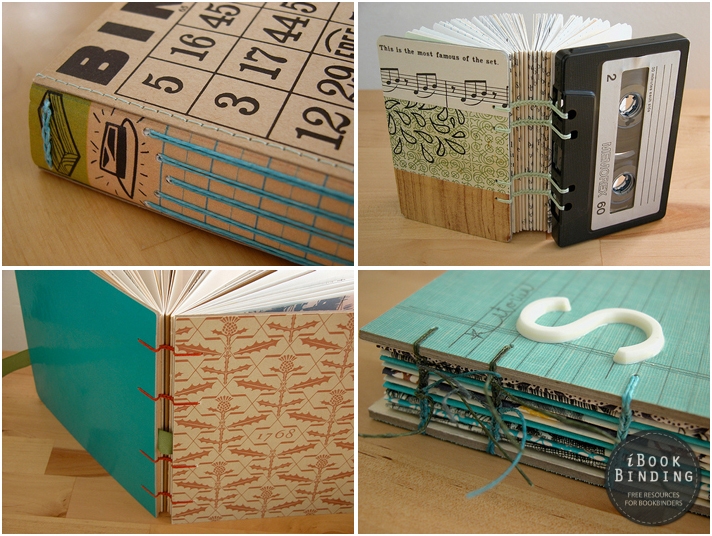09. Bookbinding Projects
Dust Jacket
As the name implies, a dust jacket can keep your work safe from dirt, wear and other sort of damages. The first step in constructing dust jacket is to select an appropriate paper that is similar to the book for which you are creating a jacket. Now measure the complete wraparound dimensions of the book. Cut a strip of paper that is about five inches wide, and crease it along the edges. Secure the paper in place with a clip as shown in figure 112. Wrap this paper around your book; pull it tight and tuck the loose end on the other side of the cover. All along, make well defined creases on the paper strip as you turn it over the book. Now remove the strip, and you would be able to see six distinct creases on it. In a similar manner, measure the height of the book with another strip of paper. The creases that are formed on the paper when you wrap it around have been illustrated in figure 113. Use these measurements to create a layout of the jacket on a separate sheet of paper. While doing this, measure the width of the flaps and ensure that it is almost one third of the cover width. If your book size is smaller, the flap width should be even more than this as shown in figure 114.
After this, you can get started with scoring, which is shown in figure 115. This would make the paper more compact and would decrease the thickness along the fold line, while ensuring the line is parallel to the edges. You can either double score or single score your jacket, both of which are shown in figures 116 and 117. Place your work onto a smooth surface, and score every fold. Take your steel ruler (the best steel ruler for bookbinding projects) and place it in line with a carpenter’s square. Use the previously created fold marks as a guide. Press the ruler firmly in its place and move the folding needle across the edge of the ruler a single stroke, as depicted in figure 118. Trim the jacket till the size is accurate, but leave the flap bevels. These are trimmed at a later stage.
Keeping the jacket onto the smooth surface, start folding along the scored lines as illustrated in figure 119. Place a ruler onto the score line, and fold the edge against the surface of the ruler. Refer to figure 120 for details. Fold all six lines in this manner.
Turn your jacket face up and trim the flap bevels. Create a label and affix it onto your work. Place the jacket onto the book, and leave your work for drying.
How best to fix your dust jacket to your book by Sarah Enni (thanks Sarah :-))
Don't forget to subscribe to our YouTube channel to get access to HD videos of hundreds of Book Binding tutorials and reviews!
Additional Resources
- Making a Dust Jacket for your Book (University of Iowa)
- eHow – How to Make a Book Dust Jacket
- Book Jacket Design Tips & Tutorials
- History of the Book Jacket
Blank Book Single Signature
Before you select paper for this project, you would have to conduct the grain test on it. Place a paper sheet onto the bench and roll it over itself. If the sheet forms an arch, it means that the grain is at a ninety degrees angle with the edge, and if the grain is parallel, the sheet would just droop down. Both a parallel and a right angled grain are shown in figure 121.
Now combine about six sheets and form the signature. The method has already been outlined in the previous chapter. Figure 122 shows how you can trim the signatures using a sharp knife and a carpenter’s square. When you are done with this, you can clip half of the signature with a peg or a clothespin as depicted in figure 123 to keep the sheets of paper in their respective positions. Doing this would ensure that the alignment remains proper.
Prepare the covers and collate the signature. Fix it in place with another clothespin so that the alignment is not disturbed. Leaving the pins in their respective positions, place the signature on a piercing board as shown in figure 125, and create holes for sewing. Generally, the signatures are sewn separately from the cover, but not so in this project. Both the cover and signature will be sewn together. The basic process is the same that was outlined in the previous chapter; the only difference is that the cover has been added to the folded signature. The complete procedure is illustrated in figures 126 to 130.
A good little saddle stitching video by Sea Lemon.
Don't forget to subscribe to our YouTube channel to get access to HD videos of hundreds of Book Binding tutorials and reviews!
The next step involves taking care of the flaps. At a distance of one eight of an inch from the front end, create a scored line on each flap as illustrated in figure 131. Cut out the bevels and tuck the flaps onto the inside of the cover as depicted in figure 132. Create and attach the label; press your work and leave it for drying.
Additional Resources
- Instructables – How to make a single signature book, a 5 minute project
- Art Lesson Plan – Making a Single Signature Book
- Making a Single Signature Book(let) by Littleput
Please Support us on Patreon!

Moreover, starting with the pledge level of $3, you will get a digitized vintage book about bookbinding, book history, or book arts each month from us!
These pledges help iBookBinding to continue its work and bring more information about bookbinding and book arts to you!























